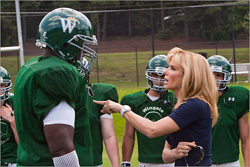The
Curious Case of Benjamin Button
Fantastic Mr. Fox
Gran Torino
Harry Potter and the Half Blood Prince
The Hurt Locker
The
Informant!
Julie and Julia
Milk
The Reader
Serious Man
Film Reviews from 2008
Film
Reviews from 2007
Film Reviews
from 2006
The Blind Side
Happily, there are many good things to be said about this true story of a wealthy suburban Memphis family, Leigh Anne and Sean Tuohy, their daughter Collins, and son S.J. (Sean, Jr.). One cold night, they see an African-American teenager, Michael (Big Mike) Oher, walking along a road without a coat or umbrella in the pouring rain. Leigh Anne recognizes him as a student (apparently the only Black student) at the private Christian school her children attend. Michael seems to have nowhere to go, so Leigh Anne brings him home and lets him sleep on the couch. After determining that Michael has no family (he was taken away from his drug-addicted mother), the Tuohys invite him to stay with him temporarily. Eventually, they become his legal guardians. I imagine the producers of The Blind Side hoped it would be a modest success. However, the film has surprised everyone by becoming a major hit. It’s good to know that there is still an audience for an appealing, real-life story, without multimillion dollars worth of special effects or comic-book superheroes. Let’s hope it starts a trend!
Michael is very large and very quiet, revealing little about himself and his past. While this characterization of Michael may indeed be valid, it makes him a difficult character for the viewer to empathize with. In later scenes in which Michael is interviewed by major college football coaches (several SEC coaches play themselves in cameo roles), S.J. in effect becomes Michael’s “agent,” negotiating with the coaches. The scenes are cute, but seem uncomfortably demeaning to Michael. Curiously, the real Michael Oher has refused to comment on the film. In the movie, as in real life, Michael does learn to become a football player at school, then goes on to be a college star at Ole Miss, and finally a successful NFL player. It’s a good, inspirational movie, about a family who takes a chance on a homeless youth from another race, and raises him as their own. But it falls short of being a great movie. The characters all seem one-dimensional. Leigh Anne says to her friends that Michael is changing her life, but do we see any change? Leigh Anne seems exactly the same at the end of the movie as she did in her first scene. Michael never reveals himself. Sean is nice and easy going, and the kids are cute. Perhaps the characters in the film are accurately portrayed. However, the movie would have been stronger if the characters had more depth. Despite its weaknesses, The Blind Side is still worth seeing. The Tuohys are an evangelical Christian family, who reach out to Michael in a way beyond all expectations because of their evangelical Christian faith. Millions of moviegoers have flocked to theaters to see their inspirational story. May this modern day parable inspire others to “go and do likewise.” Tom Condon, OP
|
The film contains brief nongraphic marital lovemaking, at least one profanity, a few sexual and drug references, and a half-dozen crass terms. The USCCB Office for Film & Broadcasting classification is A-III -- adults. The Motion Picture Association of America rating is PG-13 -- parents strongly cautioned. Some material may be inappropriate for children under 13. |



 It’s hard to be totally objective about a movie based on a true story that occurred in the city where I live. A few days after it opened, a parishioner told me that I had to see The Blind Side because it “does Memphis proud.” That’s a pretty good recommendation for a much maligned city.
It’s hard to be totally objective about a movie based on a true story that occurred in the city where I live. A few days after it opened, a parishioner told me that I had to see The Blind Side because it “does Memphis proud.” That’s a pretty good recommendation for a much maligned city.  The Blind Side focuses on the character of Leigh Anne, a strong, no-nonsense Southern woman who knows what she wants and usually gets it. Sandra Bullock gives a fine performance as Leigh Anne. Not unlike Julia Roberts playing a similar real life character in Erin Brockowitz, Bullock storms into rooms (and even football practice sessions) with high heels, tight skirts, and low cut tops. Leigh Anne is not easily intimidated. When she decides to bring Michael into her family, no one else, including her prejudiced friends, can change her mind.
The Blind Side focuses on the character of Leigh Anne, a strong, no-nonsense Southern woman who knows what she wants and usually gets it. Sandra Bullock gives a fine performance as Leigh Anne. Not unlike Julia Roberts playing a similar real life character in Erin Brockowitz, Bullock storms into rooms (and even football practice sessions) with high heels, tight skirts, and low cut tops. Leigh Anne is not easily intimidated. When she decides to bring Michael into her family, no one else, including her prejudiced friends, can change her mind.